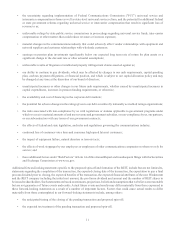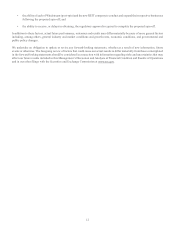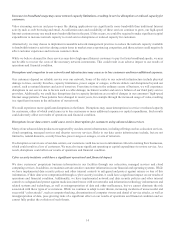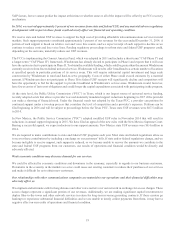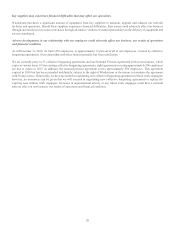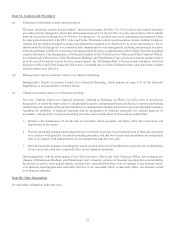Windstream 2014 Annual Report Download - page 95
Download and view the complete annual report
Please find page 95 of the 2014 Windstream annual report below. You can navigate through the pages in the report by either clicking on the pages listed below, or by using the keyword search tool below to find specific information within the annual report.
19
VoIP factors, but we cannot predict the impact at this time or whether some or all of the impact will be offset by an FCC recovery
mechanism.
In 2014, we received approximately 5 percent of our revenues from state and federal USF, and any material adverse regulatory
developments with respect to these funds could adversely affect our financial and operating condition.
We receive state and federal USF revenues to support the high cost of providing affordable telecommunications services in rural
markets. Such support payments constituted approximately 5 percent of our revenues for the year ended December 31, 2014. A
portion of such support is based on relative cost and voice line counts, and we expect receipt of such support to decline as we
continue to reduce costs and lose voice lines. Pending regulatory proceedings to reform state and federal USF programs could,
depending on the outcome, materially reduce our USF revenues.
The FCC is implementing the Connect America Fund, which was adopted in 2011 and includes a short-term (“CAF Phase I”) and
a longer-term (“CAF Phase II”) framework. Windstream has already elected to participate in Phase I and expects that it will soon
have the option to elect to participate in Phase II. To obtain the available funding, which could be greater than the amount Windstream
currently receives from frozen federal universal service, Windstream will need to offer broadband to a certain number of locations
at specified speeds in particular portions of its service areas. This will require substantial capital investment and large scale
construction by Windstream in rural and hard-to-serve geography. Costs of either Phase could exceed estimates by a material
amount. If Windstream does not participate in Phase II its federal USF receipts will significantly decline and competitors will
have the opportunity to bid for the support to provide broadband in Windstream’s service areas. Windstream would, however,
have fewer carrier of last resort obligations and could forego the capital expenditures associated with participating in the program.
At the state level, the Public Utility Commission (“PUC”) in Texas, which is our largest source of universal service funding,
recently adopted a rule that allows a provider to avoid statutorily mandated support reductions beginning in 2017 if the provider
can make a showing of financial need. Under the financial needs test adopted by the Texas PUC, a provider can petition for
continued support under a two-step process that considers the level of competition and a provider’s expenses. Petitions can be
filed beginning in 2016 and will be subject to proceedings before the Texas PUC. Texas state USF revenues were $67.5 million
in 2014.
In New Mexico, the Public Service Commission (“PSC”) adopted modified USF rules in November 2014 that will result in
reductions in annual support beginning in 2015. We have filed an appeal of the new rules with the New Mexico Supreme Court.
Barring a successful appeal, we expect reductions to our support amounts. New Mexico state USF revenues were $8.4 million in
2014.
We are required to make contributions to state and federal USF programs each year. Most state and federal regulations allow us
to recover these contributions by including a surcharge on our customers’ bills. If state and/or federal regulations change, and we
become ineligible to receive support, such support is reduced, or we become unable to recover the amounts we contribute to the
state and federal USF programs from our customers, our results of operations and financial condition would be directly and
adversely affected.
Weak economic conditions may decrease demand for our services.
We could be affected by economic conditions and downturns in the economy, especially in regards to our business customers.
Downturns in the economy in the markets we serve could cause our existing customers to reduce their purchases of our services
and make it difficult for us to obtain new customers.
Our relationships with other communications companies are material to our operations and their financial difficulties may
adversely affect us.
We originate and terminate calls for long distance and other voice carriers over our network in exchange for access charges. These
access charges represent a significant portion of our revenues. Additionally, we are making significant capital investments to
deploy fiber-to-the-tower and other network services in return for long-term revenue generating contracts. If these carriers go
bankrupt or experience substantial financial difficulties and we are unable to timely collect payments from them, it may have a
negative effect on our results of operations and financial condition.




